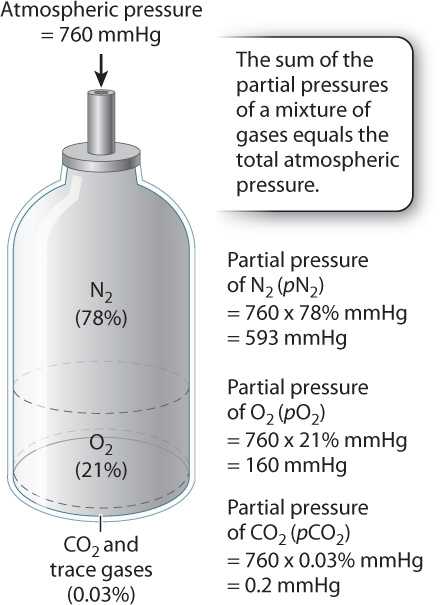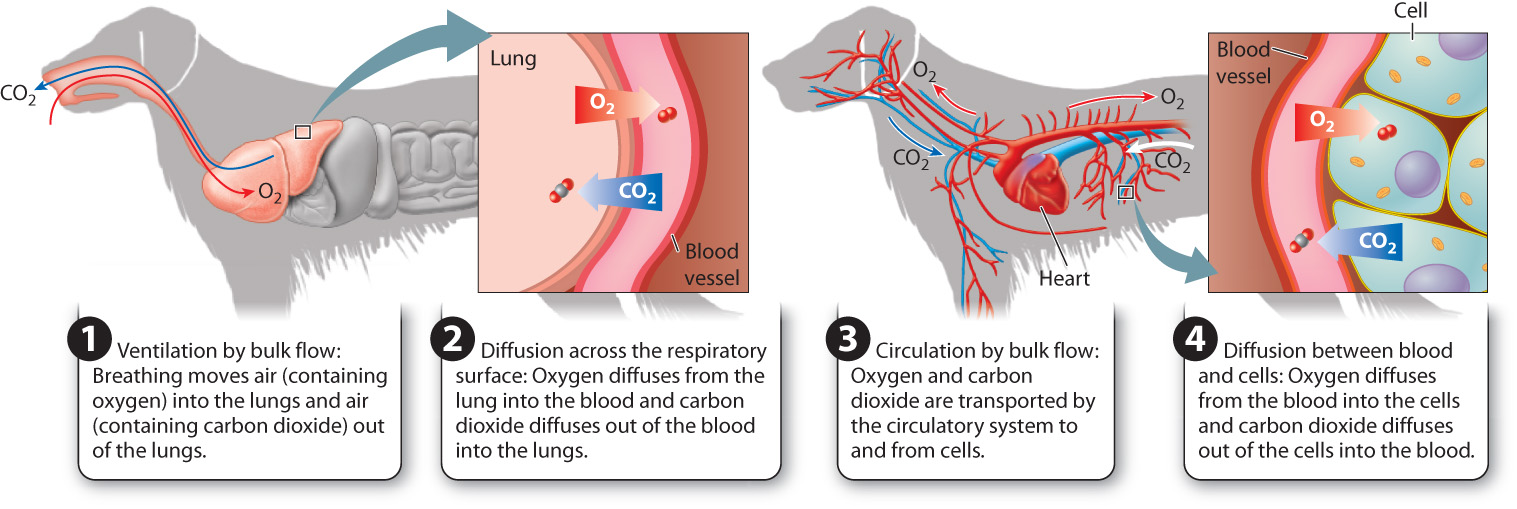39.1 DELIVERY OF OXYGEN AND ELIMINATION OF CARBON DIOXIDE
Eukaryotic cells use O2 to burn organic fuels—carbohydrate, lipid, and protein—for ATP production (Chapter 7). The increase in atmospheric O2 with the evolution of land plants was key to the evolution of O2-based cellular respiration, and that in turn contributed to the diversification of multicellular animal life during the Cambrian Period about 500 million years ago. In the process of burning fuel by aerobic respiration, CO2 is produced. Animals have thus evolved mechanisms to acquire O2 from their environment and, at the same time, to eliminate excess CO2 from their body to the environment. These mechanisms make up the process known as animal respiration—or “breathing.” The transport of O2 and CO2 between an animal and its environment is referred to as gas exchange, and is fundamental to all eukaryotic animals, as well as to photosynthetic plants.
39-2
39.1.1 Diffusion governs gas exchange over short distances.
Single-celled organisms and simple animals and plants exchange gases by diffusion. Diffusion is the random movement of individual molecules (Chapter 5). If there is a difference in concentration of a substance between two regions, diffusion results in the net movement of molecules from regions of higher concentration to regions of lower concentration until the substance is evenly distributed.

Given a large enough surface, diffusion is an extremely effective way to exchange gases and other substances over short distances between two compartments, for example between the lung and the blood vessels supplying the lung. The rate of diffusion is directly proportional to the surface area over which exchange occurs and to the concentration difference, and inversely proportional to the distance over which the molecules move (or the thickness of the barrier). Diffusion is generally ineffective over distances exceeding about 100 μm, or 0.1 mm. Consequently, respiratory and circulatory structures have large surface areas and thin membranes.
Because effective transport by diffusion is limited to short distances, some of the earliest and simplest invertebrate animals are composed of thin sheets of cells with a large surface area. For example, sponges and sea anemones have a thin body with a central cavity through which water circulates, and flatworms have a flattened body surface (Fig. 39.1).
Net movement of a substance results from diffusion when there is a concentration difference between two regions. When considering the diffusion of a gas, however, we usually refer to its partial pressure rather than its concentration. The partial pressure (p) of a gas is defined as its fractional concentration relative to other gases present, multiplied by the overall (that is, the atmospheric) pressure (Fig. 39.2). Pressure is measured in units of millimeters of mercury (mmHg). Oxygen makes up approximately 21% of the gases in air (nitrogen contributes about 78%, carbon dioxide about 0.03%, and the remainder is trace gases). At sea level, atmospheric pressure is approximately 760 mmHg, which means that O2 in the atmosphere exerts a partial pressure (pO2) of about 160 mmHg (0.21 × 760). For O2 to diffuse from the air into cells, the partial pressure of O2 inside the cells must be lower than the partial pressure of O2 in the atmosphere.

Question Quick Check 1
bnM4jK+8ixnxHBokWSoK6VE/hyLCpmMxf/g6cbWRWYo+vk/0KfiiI7zMqnRDumLxZRbSfg==39.1.2 Bulk flow moves fluid over long distances.
Larger, more complex animals transport O2 and CO2 longer distances to cells within their body. These animals rely on bulk flow in addition to diffusion. Bulk flow is the physical movement of fluid, and the gases and compounds carried by the fluid, over a given distance. Specialized pumps, like the heart, generate the pressure that is required to move the fluid.
39-3
Bulk flow occurs in two steps to meet the gas exchange needs of cells in larger animals. The first is ventilation. Ventilation is the movement of the animal’s respiratory medium—water or air—past a specialized respiratory surface. The second is circulation. Circulation is the movement of a specialized body fluid that carries O2 and CO2. The circulatory fluid is called hemolymph in invertebrates and blood in vertebrates. This fluid delivers O2 to cells within different regions of the body and carries CO2 back to the respiratory exchange surface.
Ventilation and circulation each require a pump to produce a pressure (P) that drives flow (Q) against the resistance (R) to flow. The rate of flow is governed by the following simple equation:
Q = P/R
Resistance to flow measures the difficulty of pumping the fluid through a network of chambers and vessels located within the respiratory and circulatory systems. If the resistance to flow doubles, the flow rate is halved. The longer the network of vessels and the narrower the vessels themselves, the greater the vessels’ resistance to the fluid (whether air, water, or blood) moving through them. Consider how much harder it is to blow fluid out of a long thin tube than a short wide one.
In summary, we can view gas exchange in complex multicellular organisms as four steps that are linked in series (Fig. 39.3). (1) To deliver O2 to the mitochondria within their cells, animals move fresh air or water past their respiratory exchange surface in the process of ventilation (bulk flow). Ventilation maximizes the concentration of O2 in the air or water on the outside of the respiratory surface. (2) The buildup of O2 favors the diffusion of O2 into the animal across its respiratory surface. (3) Following diffusion into the blood, O2 is transported by the circulation (bulk flow) to the tissues. Internal circulation again serves to maximize the concentration of O2 outside cells. (4) Oxygen then diffuses from the blood across the cell membrane and into the mitochondria, where it burns fuels for ATP production.

The same four steps occur in reverse to remove CO2 from the body: CO2 moves from cells to the blood by diffusion, then is carried in the circulation to the respiratory surface by bulk flow, then moves across the respiratory surface by diffusion, and finally moves out of the animal by bulk flow. Because diffusion and bulk flow are coupled, it is important that each step of transport (whether for a gas, nutrient, or waste) has a similar capacity— that is, the same amount of O2 enters the blood through diffusion as is transported by the circulation. This matching of coupled transport processes reflects an evolutionary principle of minimizing excess capacity, which is costly to the animal.